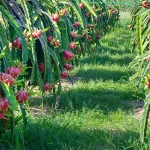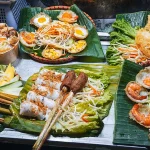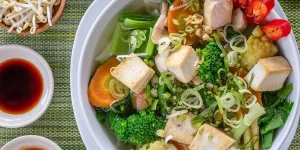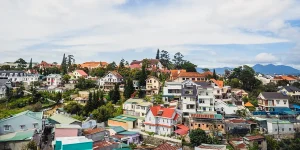It’s just before dawn in Hanoi’s Old Quarter, and the city is already awake because of a smell.
Not the roar of motorbikes – that comes later – but the low, seductive perfume of beef bones that have been simmering all night with charred onion, ginger, star anise, and cinnamon. A street vendor lifts the lid, steam curls upward, and within minutes sleepy locals are hunched over white bowls on tiny plastic stools. Paper-thin beef blushes pink in scalding broth, rice noodles soften, herbs are torn by hand. The day begins.
That bowl is phở. That moment is Vietnamese cuisine at its purest.
Light yet profound, fresh yet layered, obsessively balanced and seasonal, Vietnamese cuisine is the rare food culture that feels both effortless and impossible to copy at home. The morning bowl becomes lunch on a plastic stool, a grilled snack in a hidden alley, or a clay-pot dinner by the river — each shaped by the region you’re standing in.
From Hanoi’s sharp, clean broths to Huế’s royal spices and the south’s bold sweetness, this Vietnamese food guide helps you navigate that landscape one plate at a time.
Table of Contents
The Soul of Vietnamese Food: Five Ideas You’ll Taste in Every Bite

At its core, Vietnamese cooking is guided by five principles.
First
Absolute balance. Every dish must hit sweet (from palm sugar or fruit), sour (lime, tamarind, vinegar), salty (fish sauce), and umami all at once. Miss one and the dish feels flat.
Second
Herbs are never decoration. A bowl of phở arrives with a mountain of Thai basil, sawtooth coriander, culantro, mint, and bean sprouts on the side. You tear them in yourself until the broth turns green and fragrant.
Third
Nước mắm – fermented fish sauce – is the liquid soul of the cuisine. A few drops transform grilled pork or spring rolls into something transcendent.
Fourth
Rice is life. Steamed, broken, rolled into noodles, pounded into sheets, fermented into wine, wrapped around grilled fish.
And finally, the street is the real dining room. The best food in Vietnam is served on plastic stools no higher than your shins, under fluorescent lights, beside roaring motorbikes.
How Colonialism Shaped Modern Vietnamese Cuisine

1887–1954: the French brought baguettes, coffee, dairy, and — crucially — the habit of eating beef.
Before colonisation, cattle were work animals, most Vietnamese rarely ate beef. The French demanded steaks, so suddenly there was a supply of bones and cheaper cuts. Many food historians believe phở bò was born in the 1910s–1920s in Hanoi/Namdinh when street vendors started simmering those French leftover bones with Vietnamese spices to feed local workers.
Other obvious French-Viet mash-ups that stayed forever:
- Bánh mì – rice-flour baguette + pâté + cold cuts
- Cà phê sữa đá – drip coffee + condensed milk
- Bò kho (beef stew with carrots), bò lúc lắc (shaking beef), bánh flan, butter pastries
Vietnam took every French idea, made it lighter, cheaper, and more intensely flavoured. The colonisers left in 1954. Their best ideas never did.
Spices in Vietnamese Food: The Aromatics Behind Its Unforgettable Flavors

Vietnam is not a spicy-hot cuisine like Thailand or Sichuan. It is an explosively aromatic one. Here are the true flavor bombs you’ll smell before you see the food:
- Shallots & scallions – fried until golden or raw in every dish
- Garlic – the base note of almost everything
- Ginger – warming, especially in the cooler north
- Lemongrass – citrusy, fragrant, the soul of central and southern cooking
- Kaffir lime leaves – bright, floral, unmistakable
- Sawtooth coriander, rice-paddy herb, cilantro – the “holy trinity” of fresh herbs
- Thai basil, mint, perilla – always on the table platter
- Fresh & dried chili – used with surgical precision
- Black & fresh green peppercorns – Vietnam is the world’s largest pepper exporter for good reason
- Cinnamon, star anise, black cardamom, cloves – the warm perfume of phở broth
Vietnamese Cooking Techniques
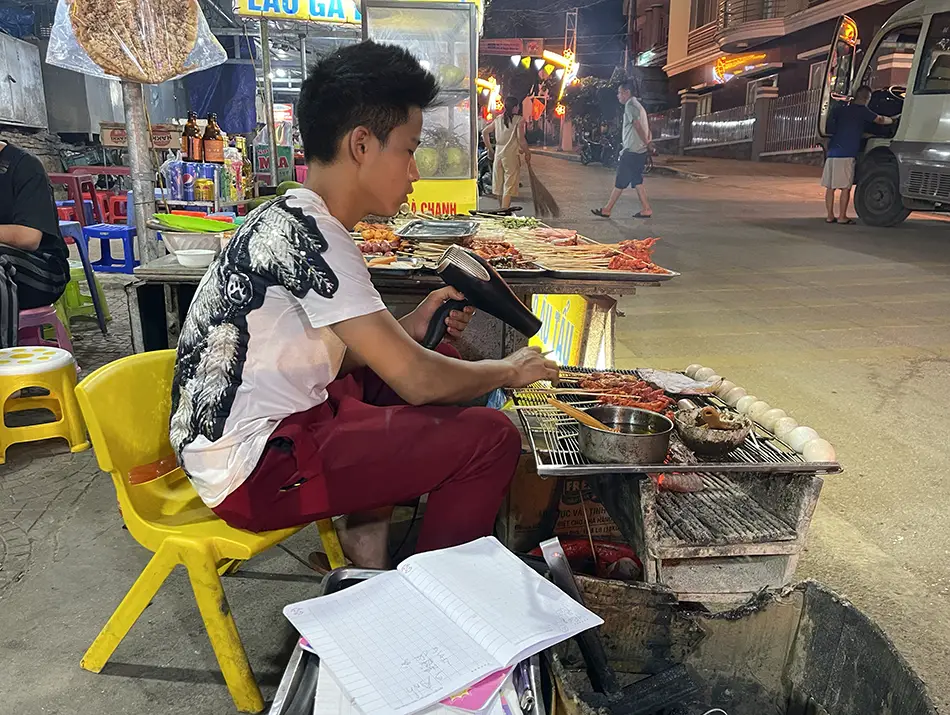
Vietnamese kitchens look basic – a wok, a pot of broth, a charcoal grill – but the techniques are masterful.
Broths simmer for up to twenty-four hours yet remain crystal clear. Meats are marinated, grilled over coconut-shell charcoal, then served with herbs so fresh they still squeak when you bite them. Clay pots turn fish and caramel into glossy, sweet-savoury masterpieces. Woks dance on high flames for exactly ninety seconds so morning glory stays emerald and prawns stay juicy.
And perhaps most brilliantly of all, the diner finishes the seasoning at the table – a squeeze of lime here, a torn handful of perilla there – so no two bowls ever taste the same.
Vietnam’s Hands-On Eating Culture

One of the most fun things about eating in Vietnam is how often you get to play with your food. In many dishes, the cook hands you the main components and a big plate of fresh herbs, lettuce, lime, chili and dipping sauce, then leaves the final assembly to you. This “build-your-own” style turns every meal into a little social game: you wrap, dip, squeeze and season exactly to your taste, and the person next to you does the same. Conversation starts instantly.
Bún Đậu Mắm Tôm – Famous DIY Street Plate
A classic northern lunch: warm rice noodles, fried tofu, boiled pork belly, herbal sausage and a bowl of pungent fermented shrimp paste (mắm tôm). You wrap everything in rice paper, dip into the purple sauce, and eat with your hands. It’s delicious, and impossible without getting involved.
Vietnamese Hot Pot (Lẩu)
A bubbling pot of flavoured broth sits on a tabletop burner, with platters of raw beef, seafood, tofu, mushrooms and greens. Diners drop in whatever they like, fish out what’s ready, swirl in noodles, and season with herbs and chili.
The broth deepens as the meal goes on, turning the last ladle into the richest sip.
Popular styles: spicy-sour Lẩu Thái, crab-tomato Lẩu riêu cua, or tamarind Lẩu cá kèo. Around 400,000–700,000 VND ($15–26 / €13–23) for four – cheap, communal, and impossible to leave hungry.
Vietnamese BBQ Buffet (Lẩu Nướng)
For 150,000–250,000 VND ($5.60–10 / €5–8) you get unlimited raw meat, seafood and vegetables plus a tabletop grill. Everyone cooks together and passes plates around. Smoke, beer and laughter are included in the price.
These interactive styles, far more common than in most countries, are what make eating in Vietnam feel like joining a friendly cooking party rather than just ordering a plate.
Regional Differences in Vietnamese Food

Vietnam’s food geography splits into three distinct regions – and once you know them, ordering becomes child’s play.
The North is subtle and refined. Flavours are cleaner, less sugar, more herb. Hanoi’s phở is delicately spiced. Its bún chả relies on perfect grilling and a light dipping sauce.
The Centre, especially imperial Huế, is the spicy, intricate heart. Dishes arrive in tiny portions because they were once created for emperors. Bún bò Huế will set your mouth on fire with lemongrass-chili oil. Cao lầu is Hoi An’s pride: thick chewy noodles made with water from one ancient well, topped with pork crackling and just a symbolic splash of broth.
The South is tropical, bold, and sweetly seductive. Coconut milk, palm sugar, and Vietnamese fruits find their way into everything. Saigon’s broken-rice plates come buried under grilled pork chops, shredded pork skin, and a sunny-side-up egg. The Mekong Delta throws freshwater fish on rice-field straw and grills them until the skin blisters.
Food Prices in Vietnam

Daily eating costs in Vietnam stay remarkably low without sacrificing quality. A bánh mì from a street cart usually sits around 25,000 VND ($1 / €0.95). A bowl of phở bò or a plate of bún at a morning stall comes close to 50,000 VND ($1.90 / €1.60).
Lunch in a local eatery — cooked-to-order stir-fries, rice plates, noodle soups — is about 70,000 VND ($2.60 / €2.30).
Tourist cafés and sit-down restaurants land higher, with mains around 150,000 VND ($6 / €5.60).
Most travellers eat two meals out, add a coffee, and grab something small in between. With that rhythm, a normal day of eating across Vietnam comes to roughly 300,000 VND ($12 / €11.30). It’s one of the few places where eating well — from street corners to cafés — stays consistently affordable.
The Best Food in Vietnam: 10 Dishes You Should Try Before Leaving
- Phở – the breakfast of champions
- Bánh mì – still the world’s greatest sandwich
- Bún chả – the dish that made Barack Obama pick up a plastic stool
- Cao lầu – Hoi An’s mysterious thick noodles with pork crackling
- Bún bò Huế – spicy, lemongrass-laced beef noodle soup that fights back
- Bánh xèo – giant sizzling rice-flour pancakes folded over prawns and beansprouts
- Cơm tấm – Saigon’s broken rice with every pork part imaginable
- Gỏi cuốn – translucent fresh spring rolls you dip in peanut sauce
- Chả cá Lã Vọng – turmeric-dill fish seared at your table (Hanoi’s 150-year-old legend)
- Cà phê sữa đá – rocket-fuel iced coffee with condensed milk
…and more you’ll discover here -> The 35 Absolute Best Dishes in Vietnam
Street Food: The Beating Heart of the Country
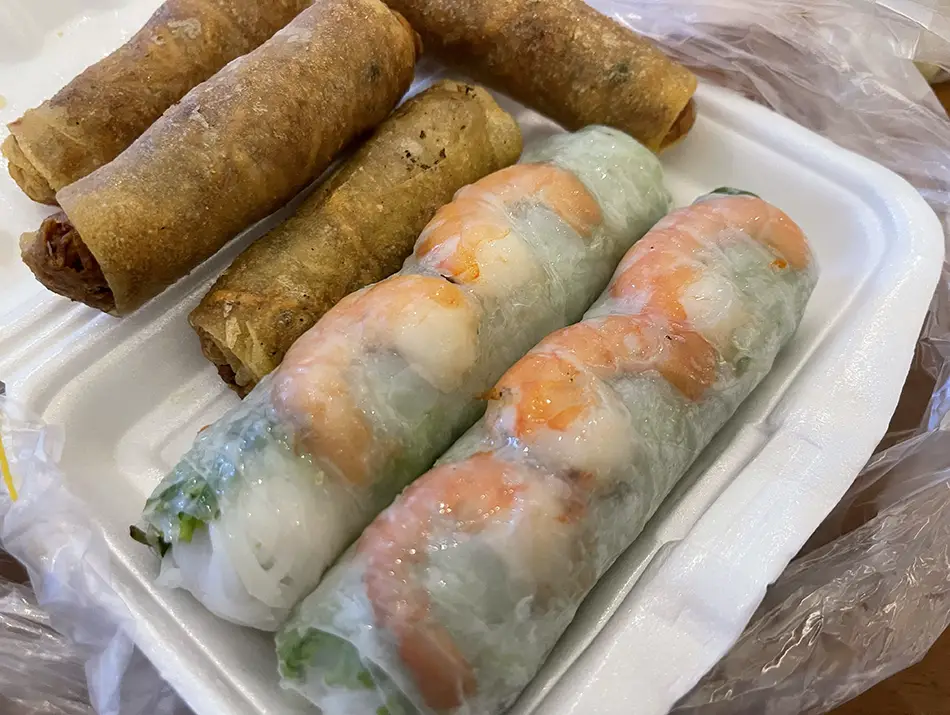
Vietnamese street food is the world’s cheapest Michelin-level eating. Where else can you get a steaming bowl of phở bò, a perfectly grilled pork bánh mì, or a giant crispy bánh xèo for the price of a single coffee back home?
For travellers it’s the fastest way to understand the country: one plastic stool, one shared table, one vendor who’s been perfecting the same recipe for thirty years. From 5 a.m. bánh cuốn steam in Hanoi’s morning markets to midnight snail stalls under Saigon neon, the sidewalk never closes.
Key facts that surprise most visitors:
- Saigon has over 8,000 registered bánh mì carts, but the real number is estimated at 20,000+.
- Vendors pay “sunshine tax”: unofficial daily fees to local ward officials for the right to occupy 2 square metres of pavement.
- Most stalls specialise in exactly one dish and have done so for 20–40 years — the same recipe, same corner, same plastic stools.
- Peak hours shift by city: Hanoi 6–9 a.m. & 6–9 p.m., HCMC almost 24/7.
Rule of thumb: longest local queue + fastest turnover = safest and best.
-> See the full guide with exact addresses, prices, and opening hours still valid in 2025: Best Street Food in Vietnam
Seafood in Vietnamese Cuisine – Fresh, Cheap, and Everywhere
With over 3,200 km of coastline and the mighty Mekong Delta, seafood is a massive part of everyday Vietnamese eating – not just a tourist splurge. It’s caught in the morning, sold in markets by noon, and grilled on street corners by sunset.
You’ll meet:
- Tôm (prawns/shrimp) – giant tiger prawns grilled with salt-chili or steamed with beer
- Mực (squid) – flash-grilled whole or stuffed with pork
- Cá (fish) – sea bass, pomfret, red snapper steamed with ginger or fried crispy
- Ghẹ (blue swimmer crabs) & cua (mud or sea crabs) – steamed, tamarind-sautéed, or in thick noodle soup
- Nghêu & sò huyết (clams & blood cockles) – stir-fried with rau muống or black-pepper sauce
- Ốc (sea snails of every size) – grilled with scallion oil or coconut milk
A unique twist in many seafood spots: restaurants with massive live aquariums where you pick your dinner straight from the tank – lobster, crab, or mantis shrimp swimming until you choose, then cooked to order for ultimate freshness.
Best seafood destinations in Vietnam are Phan Thiet & Mui Ne, Nha Trang, Da Nang & Hoi An, Phu Quoc, and Vung Tau.
Vegetarian and Vegan Options in Vietnamese Cuisine

Vietnam is one of the easiest countries on earth to eat plant-based, and the reason is simple: Buddhism. Roughly 10–15 % of the population follows a vegetarian diet at least on the 1st and 15th days of the lunar month (days of worship), and many temples and devout families go fully chay (vegetarian) year-round.
The word chay literally means “pure” and covers everything from simple rice-and-tofu plates to mind-blowing mock meats. Vietnamese chefs have been perfecting wheat-gluten “duck”, mushroom-stem “chicken”, and jackfruit “pork” for centuries. The textures and flavours are so convincing that first-time visitors regularly ask if they’ve been tricked into eating meat.
Huế is the unofficial vegetarian capital of Vietnam. Dozens of excellent chay restaurants line the streets near the Perfume River, many run by Buddhist nuns who cook with the wisdom of generations – turning humble ingredients into dishes that rival the imperial court’s old recipes.
-> For more read our complete Vegetarian Vietnam Survival Guide
The Most “Weird” Vietnamese Dishes Travelers Talk About

Vietnam’s weird foods aren’t just shock value—they’re rooted in rural traditions, seasonal availability, and beliefs in health benefits. Locals treat them as everyday protein or remedies, but for outsiders, they’re the ultimate test of open-mindedness. Start small, pair with rice wine, and remember: what smells wild often tastes surprisingly good.
- Trứng vịt lộn – A fertilized duck egg, boiled and cracked open to sip the warm broth before eating the embryonic duckling with salt, pepper, and rau răm (Vietnamese coriander).
- Tiết canh – Chilled raw blood pudding (duck, goat, or pork) mixed with lime, fish sauce, and fresh herbs until it jiggles like savory Jell-O. The metallic tang and silky mouthfeel divide opinions, but it’s a staple at northern rural feasts (and occasionally banned for health reasons).
- Đuông dừa – Fat palm grubs dug from coconut trees, eaten live in rice wine (they wriggle down) or flash-fried for a creamy, bacon-like pop. Harvested seasonally in the south, they’re prized for their high protein.”
- Thắng cố – Sapa’s infamous H’Mông horse stew: bones, offal, and tripe simmered for hours with up to 20 mountain herbs, lemongrass, and spices into a thick, medicinal broth. The aroma is intensely funky.
These aren’t on every menu, many are seasonal or require a local guide, but seeking them out unlocks Vietnam’s wilder side.
Coffee and Tea Culture in Vietnam

Vietnam is the world’s second-largest coffee producer, yet the drink remains stubbornly street-level. A small metal phin filter drips dark robusta over condensed milk and ice – that’s cà phê sữa đá, the national fuel for under a dollar. In Hanoi, the same coffee is beaten with egg yolk into cà phê trứng, a warm, velvety dessert-coffee served in decades-old cafés around Hoàn Kiếm Lake.
Tea plays the calmer counterpart. The moment you sit down at almost any restaurant or roadside eatery, a pot or glass of fresh green tea appears – always free, mostly refilled without asking. Leaves come from Thái Nguyên or ancient shan tuyết trees in the northern mountains, brewed loose and served plain. Lotus- or jasmine-scented teas show up at ceremonies. Offering and topping up someone’s glass is the universal Vietnamese way of saying “sit, relax, talk.”
Coffee kicks the day into gear. Free tea keeps the conversation flowing until the next iced coffee arrives.
Eat Like a Local: Simple Tips That Make a Big Difference

Vietnamese meals are fast, noisy, and communal. Follow these rules and you’ll blend right in:
- Slurp your phở or bún loudly; silence is rude.
- Hold the spoon in your left hand, chopsticks in your right. Use the spoon as a shovel and to sip broth.
- Tear fresh herbs with your fingers and drop them straight into the bowl; don’t arrange them neatly.
- Customise everything: add chili, squeeze lime, splash fish sauce, or spoon in sugar until it tastes perfect to you. The cook expects it.
- Sharean dishes are served family-style; take a little from each plate onto your rice bowl, never straight to your mouth.
- No one waits for everyone to be served; start eating the moment food hits the table.
- Tipping is not expected. Rounding up to the nearest 10,000 VND is plenty if you loved it.
- Eat exactly where the motorbike taxis stop – they know the best cheap spots in every neighbourhood.
- Never trust a street stall with a full English menu.
- Use GrabBike or walk one block away from any tourist sight – prices drop 50 % and quality jumps.
- Morning markets (5–8 a.m.) are where locals eat the freshest bún, bánh cuốn, xôi – cheaper and better than evening street food.
- When in doubt, order whatever the local person next to you is having.
Do these and you’ll discover the Vietnam that most visitors never get to taste.
Traveler’s FAQ to Vietnamese Cuisine
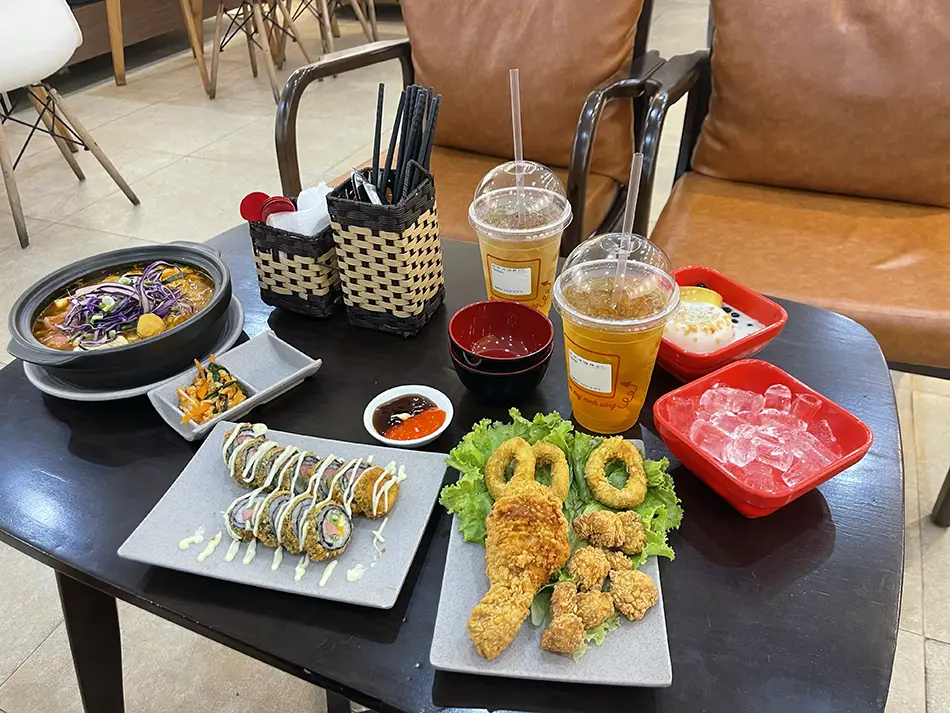
Pho, banh mi, bun cha, bun bo Hue, mi Quang, banh xeo, com tam, goi cuon, and hu tieu. These dishes represent the main regions: North, Central, and South.
Yes. Choose busy stalls with a high turnover, watch food being cooked fresh, and avoid places where food sits out too long. Markets in the morning and night are usually the safest.
Vietnamese cuisine is not spicy by default. Most heat comes from added chili on the table, not inside the dish. You control the spice level.
Many Buddhist dishes are fully plant-based: vegetarian pho, com chay, tofu stir-fries, mushroom noodle soups, fresh rolls, and vegan banh mi. Most restaurants offer meat-free versions.
Yes, depending on the region: balut (fertilized egg), coconut worms, frog dishes, snake wine, and rural meats. They’re optional—not part of daily food culture.
Street food: 25,000–75,000 VND ($1–$3 / €1–€2.8). Casual restaurant: 75,000–200,000 VND ($3–$8 / €2.8–€7.5). Coffee or juice: 25,000–45,000 VND ($1–$2 / €1–€1.9). Vietnam is one of the world’s most affordable food destinations.
One Last Bite
Vietnamese cuisine is all about the everyday: a bowl of phở at 6 a.m. in Hanoi, fresh spring rolls in Hoi An, broken rice under Saigon neon. Simple ingredients, explosive flavours, tiny plastic stools, big smiles.
That’s the real Vietnam on a plate. Come eat your way from north to south – you won’t regret a single bite.

